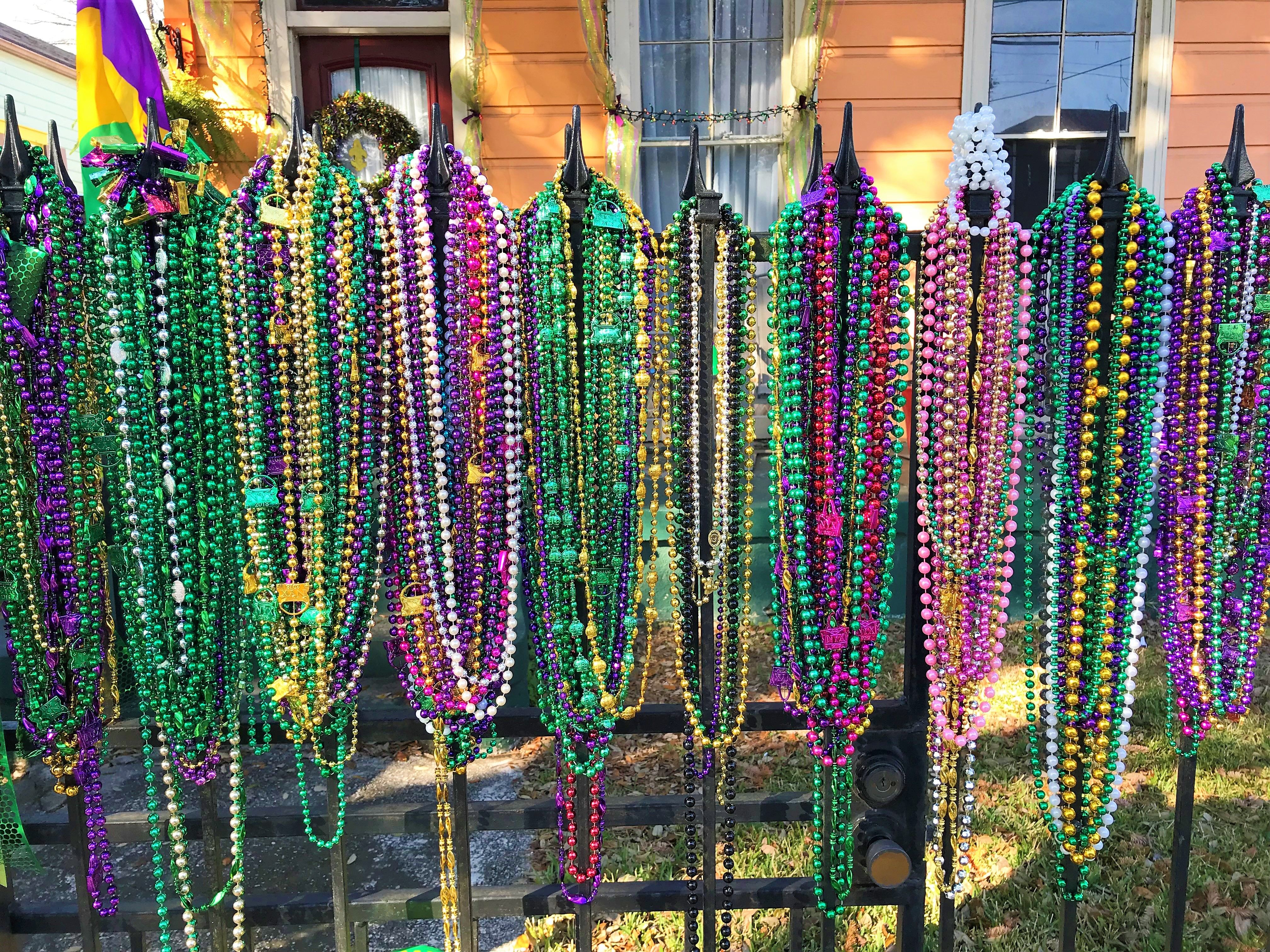Throws of Passion
Fun isn't the only motivating factor at Mardi Gras anymore. The holiday has become something of a competitive sport of Olympic proportions, with everyone trying to outdo each other at one contest or another: Who can drink the most? Put together the fanciest costume? Find the best spot on the parade route? Manage to score a Dong Phuong king cake? And, perhaps most importantly, who can get the biggest beads, the most coconuts, the best purse, and even just one Muses shoe?

Recently, Mardi Gras seems to be fundamentally about how much stuff you can collect at the parades—stuff that's stuffed, glowing, labeled, themed, flashing, hanging, noise-making, or that you can drink out of. In fact, how much Mardi Gras loot you gather is directly proportionate to how much of a good time you have. What you bring home from the parade is almost a source of self-validation, and if you don't walk away with multiple bags overflowing with primarily useless crap, well then, you feel like a failure.
Therefore, in order to catch these coveted throws, you're willing to step in front of people, knock someone down, use your children as bait, or offer bribes. You make eye contact with the float rider, you smile and beg, you offer up a fifth of whiskey—only to watch as he gives that coveted throw to the hot girl standing next to you or the tourist with the "My First Mardi Gras!" sign.
It's enough to make you throw your hands up in defeat, or to throw a fit. We all love those throws.
Because not only is there something inherently cool about getting something for free, whether you want it or not (think free donuts in the conference room), but there's something even more exciting about one-upping your neighbor to get something for free that is far better than what he got gratis (think getting the only donut in the box with rainbow sprinkles on top).
Yet Mardi Gras goodies weren't always so sought-after, and getting them wasn't always so cut-throat. How did we get to the point where we'd trade our firstborn for a light-up plastic sword; a purple, green, and gold toilet brush; or a giant plush crawfish?

Historic Carnival Throws
Carl Mack, of the Mardi Gras Museum of Costumes and Culture in the French Quarter, explains that the tradition of throwing things at Mardi Gras traces its origins to the beginnings of Carnival itself, as far back as the 1500s in Europe. Our "Carnival" is a translation of the Spanish word Carnavale, which comes from the root words for meat and go—so, in other words "meat to go," or "farewell to the flesh." Back then, they had very cold winters and would save up mountains of meat to eat during the winter months, when food was harder to come by. But as spring rolled around, whatever meat was still left over had to be consumed, and quickly, before it went bad. So, everyone would party and feast and gorge themselves on meat to deplete the supplies, and all that carnivorous cavorting became knowns as Carnavale. Afterwards, no one ate meat for quite some time, either because overindulgence made it lose its appeal or religion required it. Those months of meatlessness became known as Lent.
As part of early Carnavale festivities, the nobility would disguise themselves with masks, so as not to be recognized, or else dress up in their fanciest clothes, and ride through the town trying to endear themselves to the peasants by showering them with gifts and tokens. They threw them beads and coins, which, at the time, were actually worth something.
"If you open up a Spanish treasure chest, what have you got inside? Beads and coins. That was currency," says Mack. "Manhattan Island was bought for a bunch of beads." (These days, beads won't even get you so much as a bagel in New York City.)
So began the tradition of throws.
The custom continued in Paris and other European cities as big-hearted merrymakers would distribute sweets (such as sugar-coated almonds) to onlooking ladies—a practice that was carried over to New Orleans in the 1830s, when women on French Quarter balconies were flung candy from below.
The first known throws from a Mardi Gras float came from Santa himself, riding in the Twelfth Night Revelers parade on January 7, 1871. This Carnival Claus exhibited his usual generosity, throwing plenty of gifts—allegedly from the famous "variety, curiosity," and toy store Piffet's on Canal Street—to eager parade-goers.
21st Century Throws
Although the revered Krewe of Rex began throwing metal medallions—likely the precursors to doubloons—as early as 1884, the doubloon was officially invented by Rex in 1960. That year, the krewe tossed as many as 80,000 of these metal coins in their parade, all of them etched with the krewe's insignia. This was the first time that throws were exclusive to a particular krewe, a custom that is commonplace today—everything from plastic cups to rubber duckies, Frisbees to footballs now come adorned with a krewe name and logo.
By 1921, Rex was insisting that its members pass out throws during parades, and the distribution of Mardi Gras swag was forevermore ingrained in Carnival culture.
Early beads were relatively upscale necklaces made of hand-blown glass and cut crystal from Czechoslovakia, which were the norm until right around WWII. By the 1950s and 60s, however, the material had been switched to plastic and the manufacturing moved to China. Today, of course, China has its hands in our Mardi Gras as much as it does in our politics. An estimated 25 million pounds of Mardi Gras beads are thrown each year (roughly the equivalent weight of the Eiffel Tower), the majority of which are made in China, along with countless other plastic gadgets and goodies thrown to the throngs.
"The people in China who are making these big plastic cigars [that the Krewe of Zulu throws] are probably wondering why New Orleans needs 20,000 plastic cigars a year," says Mack.
In recent times, throws have gotten more sophisticated, more elaborate, more diverse—and more expensive. Dan Kelly of the iconic Mardi Gras store Beads by the Dozen estimates that the throw business today is a $30 million industry in New Orleans alone, generating $50 million to $60 million nationally. While krewe members used to be able to get away with dropping just a couple hundred bucks on parade giveaways, they now regularly throw down as much as a couple thousand on throws—an increase in expenses commonly referred to as "bead inflation." And what isn't purchased is hand-made, as krewe members get creative and crafty, devoting immeasurable hours all year long to painting coconuts, glittering shoes, and embellishing purses.

Throw Etiquette
With all these many prizes being flung from floats, something needs to keep it all in check to avoid total chaos. Therefore, when it comes to what can and can't be thrown from a float, "there are rules," Mack points out. Nothing is allowed that is commercially branded, overtly dangerous, or unsanitary. In the 1980s, following multiple coconut calamities as parade-goers were injured by the weight and trajectory of these throws, a law was passed that coconuts must now be gingerly handed down from floats (and yet throwing hefty strings of massive beads is still fair game). No food can be thrown, unless packaged—a rule that is clearly thrown by the wayside when it comes to St. Patrick's Day parades. And in addition to being just plain uncool, flashing for beads is also technically illegal. In case you're wondering where this custom of questionable taste originated, Mack explains: "That really grew out of trying to catch the attention of a float rider. Here comes this float moving down the street, and you've got thousands of people trying to catch their attention. You've got about five seconds" to stand out. Yes, indecent exposure is always a sure way to get noticed, even in New Orleans.
Scoring bags full of throws at every parade is kind of a mixed bag. Besides the high you get from winning piles of take-home souvenirs for free, catching throws makes Mardi Gras parades not only something you watch, but something you really take part in—the difference between standing on the sidelines and really getting into the game.
But on the other hand, Mardi Gras festivities produce some 50 to 80 million pounds (the weight of half a million beer kegs) of non-recyclable garbage, much of which comes from discarded throws. We have beads clogging our gutters and weighing down our trees. Yet we also repurpose beads for art, costumes, and home décor, and bead-recycling programs provide local jobs. Throws give us color and vibrancy, memories and stories. They are collector's items.
When it comes down to it, Mardi Gras just wouldn't be Mardi Gras without throws. And although the parades may be canceled this year, we will always carry on the Mardi Gras spirit—that New Orleans flair. Whatever life throws our way.

